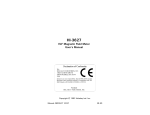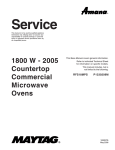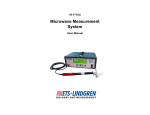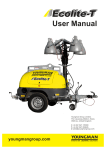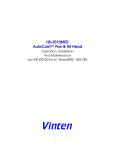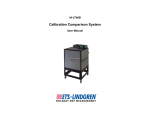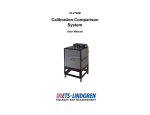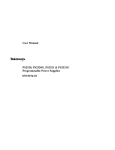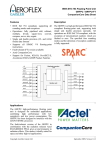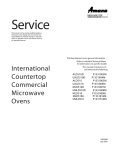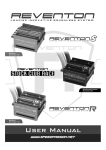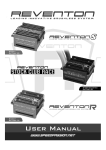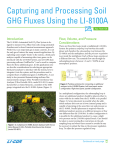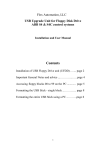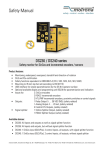Download HI-1710 Microwave Measurement System User Manual
Transcript
Archived 4/2/10 HI-1710 Microwave Measurement System User's Manual Copyright Manual #600032 © 2000 by Holaday Industries, Inc. 2/00 $25.00 Archived 4/2/10 Revision Record Manual #600032 HI-1710 Microwave Measurement System Revision G Description Reformatted Date 2/00 Archived 4/2/10 TABLE OF CONTENTS 1.0 DESCRIPTION . . . . . . . . . . . . . . . . . . . . . . . 1 Introduction . . . . . . . . . . . . . . . . . . . . . . . . 1 2.0 HIn1710 SPECIFICATIONS . . . . . . . . . . . . . 3 Error Analysis . . . . . . . . . . . . . . . . . . . . . . . 4 Calibration . . . . . . . . . . . . . . . . . . . . . . . . . 5 3.0 ACCEPTANCE . . . . . . . . . . . . . . . . . . . . . . 5 Introduction . . . . . . . . . . . . . . . . . . . . . . . . 5 Unpacking and Acceptance . . . . . . . . . . . . . 5 4.0 OPERATIONS . . . . . . . . . . . . . . . . . . . Start Up . . . . . . . . . . . . . . . . . . . . . . . Front Panel Settings . . . . . . . . . . . . . . Default Settings . . . . . . . . . . . . . . . . . Range . . . . . . . . . . . . . . . . . . . . . . . . Filter . . . . . . . . . . . . . . . . . . . . . . . . . Peak Hold . . . . . . . . . . . . . . . . . . . . . Alarm Set . . . . . . . . . . . . . . . . . . . . . Zero . . . . . . . . . . . . . . . . . . . . . . . . . Over Range . . . . . . . . . . . . . . . . . . . . Shift Functions . . . . . . . . . . . . . . . . . . Bias . . . . . . . . . . . . . . . . . . . . . . Offset . . . . . . . . . . . . . . . . . . . . Reset . . . . . . . . . . . . . . . . . . . . . Power Supply . . . . . . . . . . . . . . . 3/4 Digit . . . . . . . . . . . . . . . . . . . Set Baud Rate . . . . . . . . . . . . . . . Stim . . . . . . . . . . . . . . . . . . . . . Using the HI-1710 . . . . . . . . . . . . . . . . Analog Outout . . . . . . . . . . . . . . . . . . Digital (RS-232) Input/Output . . . . . . . . Error Messages . . . . . . . . . . . . . . . . . . Connection and Operation of the RS-232 Serial Data Port . . . . . . . . . . . . . . . . . . . . . . . . . . . . . . . . . . . . . . . . . . . . . . . . . . . . . . . . . . . . . . . . . . . . . . . . . . . . . . . . . . . . . 9 . 9 10 10 11 12 13 16 16 17 17 17 18 18 18 18 18 18 19 20 21 26 . . . 27 Archived 4/2/10 5.0 THEORY OF OPERATION . . . . . . . . . . . . . . 35 6.0 TEST AND TROUBLESHOOTING Error Codes . . . . . . . . . . . . . . Checks and Adjustments . . . . . Chip Revisions . . . . . . . . . . . . Replacement Parts . . . . . . . . . . . . . . . . . . . . . . . . . . . . . . . . . . . . . . . . . . . . . . . . . . . . . . . 41 41 43 45 46 APPENDIX A RS-232 Command Set . . . . . . . . . . . . . . . . 49 APPENDIX B RS-232 Connections . . . . . . . . . . . . . . . . . 51 APPENDIX C Zero Receptacle . . . . . . . . . . . . . . . . . . . . 53 Archived 4/2/10 Limited Warranty Holaday Industries, Inc. warrants each model HIn1710 Microwave Measurement System to be free from defects in material and workmanship for a period of one year from the date of shipment to the purchaser. This warranty extends to the original purchaser only, and does not apply to the batteries or to any products or parts subject to misuse, neglect, accident, unauthorized service or abnormal conditions of operation. In the event an instrument covered by this warranty fails, Holaday Industries, Inc. will, without charge, repair and recalibrate the instrument if returned to their factory within one year of the original purchase-provided that Holaday Industries' examination discloses, to its satisfaction, that the product is defective. Holaday Industries, Inc., may, at its option, replace the product in lieu of repair. If the defect was caused by misuse, neglect, accident, unauthorized service or abnormal conditions of operation, repairs will be billed at a nominal cost. In such cases, an estimate will be provided before work is started, if requested by the purchaser. For warranty service, contact Holaday Industries, Inc. Provide the serial number of the instrument and complete details regarding the failure mode. You will then be given either service information or shipping instructions. Return the instrument to the factory, transportation prepaid. Repairs will be made at the factory and the instrument will be returned to you, transportation prepaid. Holaday Industries, Inc., assumes no responsibility for loss of, or damage to, products in transit. Warning! EXTREME CAUTION IS ADVISED WHEN WORKING IN ENVIRONMENTS WHERE HIGH-INTENSITY ELECTROMAGNETIC FIELDS MAY EXIST AND WHERE CONTACT WITH HIGH VOLTAGE OR HIGH CURRENT CIRCUITS OR APPARATUS IS POSSIBLE. ACCIDENTAL CONTACT WITH OBJECTS OR CIRCUITS OPERATING AT HIGH VOLTAGES OR HIGH CURRENTS CAN BE LETHAL! HOLADAY INDUSTRIES, INC. ASSUMES NO LIABILITY FOR ANY DAMAGES OR PERSONAL INJURY WHICH MAY RESULT FROM Archived 4/2/10 HIn1710 Manual Page — 1 1.0 DESCRIPTION Introduction The HI-1710 Microwave Measurement System is designed to operate from standard 50/60 Hz. 115 or 230 VAC power. The circuitry is powered by a regulated supply with normal industrial transient protection devices. The push button power switch located on the front panel of the instrument turns the instrument on and off. The instrument provides four different time response characteristics which allows standard hand scan measurements according to CDRH Performance Standard for Microwave Ovens, CFR 1030.10 as well as the potential for faster scanning similar to that of automated scanning systems. The instrument is calibrated for measurement in the 2450 MHz ISM band only. The instrument is shielded with the necessary isolating and attenuating devices to provide immunity to stray leakage of microwave energy. The diode detection array of eight hot carrier diodes is housed in the large end of the plastic probe assembly. This antenna array has the unique feature of being able to sum microwave electric fields of any plane perpendicular to the axis of the probe. The antenna lobe is also very broad, making the instrument easy to use when measuring leakage around an oven door. The cone spacer is designed to provide 5 cm spacing (as required by the CDRH performance standard) from the tip of the probe cone to the center of the array. The shape of the cone provides minimum perturbation of the electric field impinging on the diode array. The probe is attached permanently to the pre-amplifier assembly by a 9 foot shielded cable. Each detection probe and amplifier assembly is calibrated as a unit and can be used interchangeable with any HI-1710 Readout. The digital Archived 4/2/10 Page — 2 HIn1710 Manual indicator reads with two or three decimal place resolution from zero to 10 mW/cm2. Temporary over-exposure to microwave fields up to 2000 mW/cm2 will not cause probe burn-out or damage the instrument or its calibration. Four ranges with full scale indications of 1, 2, 5, and 10 mW/cm2 or auto-range can be selected from the front panel. With the instrument set to auto-range, the microprocessor controller will select the best range for each measuring condition. Selecting the range, determines the full scale setting of the bar graph display located below the digital readout to give a continuous analog indication of the leakage level being measured. The audio alarm circuit can be set to any level up to 10 mW/cm2. Whenever the level of the microwave leakage exceeds the preselected value, the audio alarm will sound, alerting the operator that the chosen level has been exceeded. Archived 4/2/10 HIn1710 Manual Page — 3 2.0 HIn1710 SPECIFICATIONS 1. Calibrated at 2450 MHz. for use in the ISM band. 2. Four ranges: 0-1, 0-2, 0-5, 0-10 mW/cm2. 3. Response Characteristics (0 to 90% of final value for step input): F1 - 1.2 seconds (2 stage Butterworth filter, Fc = 0.5 Hz.) F2 - Less than 0.5 second (2 stage Butterworth filter, Fc = 0.5 Hz.) F3 - Four Pole Butterworth filter, Fc = 0.45 Hz. F4 - Four Pole Butterworth filter, Fc = 0.90 Hz. 4. Maximum Power Density 2.0 Watts/cm2 (2000 mW/cm2) 5. Power: 115/230 selectable) 6. Operating Temperature: 15/ - 40/ Celsius 7. Dimensions: 11 (280x204x165mm) 8. Probe Length: 12 inches (305 mm) Cable Length: 9 feet (2.74 meters) 9. Shipping weight: 15 pounds (6.8 KG) VAC x 50-60 8 Hz. x 6.5 (switch high Archived 4/2/10 Page — 4 Error Analysis HIn1710 Manual 1.0 mW/cm2 Absolute Calibration +0.30 dB Precision ±0.13 Linearity and AM response ±0.15 Frequency Response1 ±0.04 Near field response ±0.29 Polarization1 ±0.21 Pattern +0/-0.11 Temperature +0.46/-0.15 Supply Voltage ±0.01 RFI1 ±0.01 Overload ±0.01 Drift1 ±0.04 ________________ -1.098/+1.498 dB note 1: values are combined in an RMS manner Archived 4/2/10 HIn1710 Manual Page — 5 Calibration Each Probe/preamp assembly is calibrated by placing the probe in a known 2450 MHz field. Calibration is performed at a standard temperature of 75 degrees Fahrenheit in an anechoic chamber, utilizing a slot radiator. A CW field is generated using a crystal controlled solid state source. The power monitoring system is the HI-2795 Calibration Comparison System. The calibration field level is established using a reference survey meter with CDRH calibration correction factors. All ranges are calibrated at mid-scale. Archived 4/2/10 Page — 6 HIn1710 Manual Archived 4/2/10 HIn1710 Manual 3.0 Page — 7 ACCEPTANCE Introduction This section contains information on unpacking and acceptance of the HIn1710. Unpacking and Acceptance Step 1. Upon delivery of your order, inspect the shipping container(s) for evidence of damage. Record any damage on the delivery receipt before signing. In case of concealed damage or loss, retain the packing materials for inspection by the carrier. Step 2. Remove the instrument from its shipping containers. Save the boxes and any protective packing materials for future use. Step 3. Check all materials against the packing list to verify that the equipment received matches that which was ordered. If you find any discrepancies, note them and call Holaday Customer Service (952-934-4920) for further instructions. Be sure that you are satisfied with the contents of your order and the condition of your equipment before installing the instrument. Archived 4/2/10 Page — 8 HIn1710 Manual Archived 4/2/10 HIn1710 Manual Page — 9 4.0 OPERATION Start Up (The instrument should not be used without spacer cone in place.) 1. Insert the probe/preamp tube into the receptacle in the HI-1710 front panel with the power OFF. The preamp tube must be oriented with the locating screw facing up. Be sure that the pins are securely mated with the socket in the instrument front panel. Note that the preamp tube is inserted into the probe opening such that the indicator arrow on the brass tube is aligned with the edge of the grounding ring. 2. Check that the input voltage select switch (located on the rear panel of the unit) is set to the proper voltage level. Connect theinstrumentto the AC supply line. 3. Power is applied to the system by depressing the power switch located in the upper right corner of the instrument front panel. When the power is first turned on, the microprocessor performs a series of self-tests on the measuring circuitry of the meter. Refer to section 6.0 (Test and Trouble Shooting) for more information. When the initial tests are complete, the system is in its default mode and ready for operation. 4. Check the spacer cone for damage, discoloration, or contamination. Accuracy will be affected by cone wear or damage or by contamination by metallic particles which may become imbedded in the cone. Replace the cone if necessary. Replace the cone only with a Holaday Industries replacement cone for Archived 4/2/10 HIn1710 Manual Page — 10 continued accuracy. Front Panel Settings Refer to figure 1 Figure 1 HI-1710 Front Panel Default Settings When the instrument is turned on, the instrument is initialized to pre-determined default settings. The instrument can be used for normal production line testing with the default settings. The ALARM SET POINT is saved in Battery Backed RAM and will return to its preset value each time the instrument is turned on or reset. This value is initially set near the top of the operating range during factory testing. The RS-232 serial port baud rate setting is also saved in RAM. Its initial value is set to 1200 baud during factory testing. Archived 4/2/10 HIn1710 Manual Page — 11 Default Settings: Peak Hold Filter Range Display - OFF FILTER 1 (Slow) 0-1 mW/cm² Two Decimal Places Range The HI-1710 can be set to any one of four ranges by pressing either of the range select switches. The range affects only the Bar Graph Display and the Analog Output; the digital display will always indicate any value between zero and 10 mW/cm2. Pressing the right range switch (>) changes the instrument to the next higher range; each depression of the switch moves one range. Pressing the left range switch moves the range downward. Moving one step beyond range four (10 mW/cm2 full scale), sets the instrument to AUTO-RANGE. In this mode, the instrument adjusts the range automatically for the best reading. With no RF input, the instrument will shift to the 0-1 mW/cm2 scale. When the displayed value exceeds 95% of full scale, the instrument automatically selects the next higher scale. While the digital reading will always indicate any value up to 10 mW/cm2, the Bar Graph display will change to reflect the correct percentage of the newly selected range. In auto-range, when the displayed value drops below 30% of full scale, the instrument selects the next lower range. Note: When using the Auto-Range feature and Peak Hold together, the highest range selected is locked in. This is because the peak segment on the Bar Graph display is located as a proportion of the highest auto-selected range. When the instrument is zeroed, the auto-range Archived 4/2/10 Page — 12 HIn1710 Manual will reset to the lowest range (1 mW/cm2). The range selection switches feature wrap-around operation which means that when the instrument is in its lowest range and the left or lower range (<) switch is pressed, the instrument will move to the auto-range setting. When the instrument is in auto-range and the right or increase range switch (>) is pressed, the instrument will move to the 1 mW/cm2 setting. Filter The HI-1710 is internally programmed with four response times (filters). This digital filtering changes the way the instrument responds to rapidly changing RF or leakage levels. Refer to section 5.0 (Theory of Operation). Filters are selected by pressing the right or left filter select switches located beneath the filter selection indicating LEDs on the front panel. Filter 1 is equivalent to the "SLOW" response mode on analog meters. This is the default setting and is the setting used for most hand scanning of microwave ovens. This setting responds more slowly to rapidly changing RF or leakage levels and tends to average the response to peak levels caused by oven mode stirring devices. This response characteristic is designed to meet the CDRH requirement that an instrument respond to a step CW microwave input to 90% of its steady state reading within a maximum of three seconds while still providing maximum smoothing of RF peaks. Filter 2 is equivalent to the "FAST" response mode on analog meters. The filter selection is used for observing rapid variations in RF leakage and evaluating the effect of stirrer modulation on leakage. Archived 4/2/10 HIn1710 Manual Page — 13 Filter 3 is a four stage, eight pole filter designed for faster scanning of ovens having slow mode stirrer speeds in a manner similar to that used by Automatic Microwave Oven Scanning Systems (AMOSS). Special test procedures are required to use this filter for compliance testing. Filter 4 is a four stage, eight pole filter designed for faster scanning of ovens having faster mode stirrer speeds in a manner similar to that used by Automatic Microwave Oven Scanning Systems (AMOSS). Special test procedures are required to use this filter for compliance testing. Note: Use of Filters 3 and 4 would require the development and submission of a revised compliance plan with CDRH. Such a plan would need to show an error analysis of sample data comparing the proposed scan rate with current CDRH testing guidelines. Contact Holaday Industries for further information. Peak Hold The Peak Hold function captures and holds the highest leakage reading displayed by the instrument. Peak Hold is activated by pushing the Peak Hold switch on the front panel. An LED indicator lights to show that the instrument is in the Peak Hold mode. The peak reading is stored as a digital value and displayed until the Zero switch is pushed to reset the instrument or until the probe is inserted into the optional Zero Chamber. The peak reading displayed is the value obtained following all filtering and signal conditioning. While in Peak Hold, the analog Bar Graph display shows the current instantaneous RF reading, without filtering (refer to figure 2). A Bar Graph segment remains lit to Archived 4/2/10 HIn1710 Manual Page — 14 indicate the relative location of the peak reading on the digital display. The Bar Graph display responds very rapidly and will show stirrer/turntable modulation as well as minima and maxima of leakage around the microwave oven periphery. Because of the fast, unfiltered, response of the Bar Graph display, the digital peak reading may lag behind the Bar Graph indication depending on the filter factor chosen. When the instantaneous RF indication on the Bar Graph display is greater than the reading on the digital display, the Bar Graph segment proportional to the digital reading is dark. In this way the Peak Hold mode of the meter can be used to observe the effects of the various digital filters on fast changing RF inputs. Bar Graph Display Two end segments are always lit to define the scale. Archived 4/2/10 HIn1710 Manual Page — 15 In NORMAL mode, the Bar Graph tracks the digital display. In PEAK mode, a single segment stays lit to indicate the peak reading on the digital display. Bar Graph segments track the instantaneous RF level. In PEAK mode, when the instantaneous RF level exceeds the filtered “peak” level on the digital display, the “peak” level is indicated by an unlit segment. Figure 2 HI-1710 Bar Graph Display Archived 4/2/10 Page — 16 HIn1710 Manual In the normal (non-PEAK HOLD) mode, the Bar Graph display follows the filtered display reading. Alarm Set The HI-1710 has an audible alarm feature to indicate that the measured leakage has exceeded a preset level. The Alarm Set function is controlled by two front panel touch switches. The upper switch raises the set point and the lower switch lowers the set point. Pressing either switch momentarily displays the current alarm set point on the digital display as well as causing the Bar Graph to display the alarm set point as a percentage of the current range setting. If either switch is pressed continuously, the alarm set point will begin to increase or decrease depending on the switch activated. The rate at which the set point changes increases as the switch continues to be pressed. To slow the change rate for precise settings, momentarily release the switch and then activate again. The alarm is set to the high end of the scale at the factory. Note that the alarm will sound only when the displayed RF value exceeds the alarm setting, e.g. if the alarm is set at 4.99 mW/cm2, the alarm will only sound when the displayed RF level is 5.00 or greater. Zero The zero switch subtracts the current offset reading from the probe from the currently displayed RF reading. This, in effect, subtracts a number from itself resulting in zero. It is important to note there must be no RF present in the vicinity of the probe when the zero switch is activated. Doing so will cause an inaccurate zero. The zero will drift as the instrument's electronic circuitry and diodes warm Archived 4/2/10 HIn1710 Manual Page — 17 up to normal operating temperature. There will also be small variations as the ambient temperature changes during the day. For these reasons, the zero point of the instrument must be reset periodically. In addition, the bias and offset readings are checked against preset internal limits each time the zero switch is activated. If the limits are exceeded, an error message is displayed. Zeroing the instrument in a sufficiently high RF field or zeroing the instrument with the probe removed will also cause an error. These tests measure the performance characteristics of the probe and serve as failure indicators. Over Range If the unfiltered RF signal from the probe exceeds 20 mW/cm2 or the filtered RF signal exceeds 10 mW/cm2, the over range indicator will turn on. The over range indication is latched to indicate that a signal has exceeded the measuring capabilities of the system. The over range condition is reset when the instrument is rezeroed. Shift Functions Several additional performance indicators and settings are available at the front panel through the use of shifted touch switches. To indicate a shifted function, press and hold the zero switch while activating one of the shifted switches. Note that some shifted switches are not marked on the front panel. Bias (shift ALARM SET Increase [v]) - Displays the probe bias reading. This value should be between 0.300 and 0.4.00 volts. Archived 4/2/10 Page — 18 HIn1710 Manual Offset (shift ALARM SET Decrease [w]) - Displays the probe offset reading. This value should be between 0.005 and 0.100 volts. Reset (shift RANGE Increase [>]) - Resets all the instrument parameters to their default settings and repeats the self-test. Note that the Alarm Set Point and Baud Rate do not change on RESET. Power Supply (shift RANGE Decrease [<]) Displays the internal power supply voltages in sequence: Voltage +4.000 +5 +8.00 -8.00 Acceptable Range 3.995 - 4.005 4.75 - 5.25 7.60 - 8.40 7.92 - 8.08 3/4 Digit (shift FILTER right [>]) - Alternately selects 3 or 4 digit display (two or three decimal places). Set Baud Rate (shift FILTER left [<]) - Changes the baud rate of the RS-232 serial communication port. When the switch is initially activated, the current baud rate is displayed for two seconds. If the switch is held, the baud rate will sequence through its range of values: 1200 - 600 - 300 - 19.2K - 9600 - 4800 - 2400 Release the switch when the desired baud rate is displayed. Stim (shift PEAK HOLD) - When activated, applies a Archived 4/2/10 HIn1710 Manual Page — 19 dc voltage to the input of the RF signal circuitry. The displayed reading should be between 2.44 and 4.88. Readings outside this range indicate a fault in the HI-2623 probe/preamp. Using the HI-1710 Allow the instrument to warm up for at least 10 minutes for specified accuracy and stability. Set the operating settings according to the test needs. For normal tests or a good beginning point, use the default conditions. Zero the instrument before beginning the test. With the oven operating with a suitable load, move the probe across the oven surfaces keeping the probe axis (handle) perpendicular to the potential leak area. Note: Check the spacer cone for damage, discoloration, or contamination. Accuracy may be affected by cone wear or damage or by contamination by metallic particles which may become imbedded in the cone. Replace the cone if necessary. Replace the cone only with a Holaday Industries replacement cone for continued accuracy. Refer to section 6.0 (Test and Troubleshooting) for part numbers. Hold the probe by the red handle only to avoid potential interference and keep other parts of the body and the probe cord away from the immediate vicinity of the probe head. The analog Bar Graph display may be used to determine areas of highest leakage. In the normal ( non-Peak Hold) mode the Bar Graph display will track the displayed digital value and respond to the filtered RF signal. When the instrument is operated in the Peak Hold mode, the Bar Archived 4/2/10 Page — 20 HIn1710 Manual Graph display is not filtered and responds very rapidly to changes in RF intensity. The Peak Hold mode may be used, while scanning, to capture the area of highest leakage while the Bar Graph will continuously display instantaneous variations in leakage. Changing the filter selection to F2 will decrease the response time of the system. This will more effectively show the effect of rapid variations in RF levels due to mode stirrers or other modulating devices. In both the F1 and F2 filter positions, the response time meets the CDRH (US Government) requirement for RF measuring instrument response times while the F1 response characteristic provides maximum smoothing of RF variations. Note: Do not use filter selection F3 and F4 for US compliance testing without prior approval of CDRH. Contact Holaday Industries for further information. After the test is completed and the RF reading recorded the instrument should be zeroed by activating the ZERO switch before the next test. The zero point may gradually drift over long periods. Re-zero the instrument before beginning a test. Analog Output An analog output is available on the rear panel of the HI1710. This is the BNC receptacle just to the right of the 25 pin RS-232 receptacle. The analog output is a dc voltage varying from zero to four (0-4) volts proportional to the full scale range setting of the instrument. For example, with the instrument on range 2 (0-2 mW/cm2), a leakage value of 2 mW/cm2 will have an analog signal of 4 VDC and a 1 mW/cm2 value will have a signal of 2 VDC. On range 4 (0-10 mW/cm2), the four (4) volt Archived 4/2/10 HIn1710 Manual Page — 21 analog output signal will indicate 10 mW/cm2. Figure 3 HI-1710 Rear Panel Important: The resistance of the external load connected to the analog output receptacle should not be less than 5000 ohms. Digital (RS-232) Input/Output A full, two-way RS-232 serial data port is provided as standard equipment on the HI-1710. External devices are connected through the standard 25 pin RS-232 receptacle at the rear of the instrument. These external devices can monitor and/or control the HI-1710. Refer to Appendix B for pin designations. With the serial data port, all functions normally accessed by the touch switch inputs can be controlled externally and all data normally displayed can be transmitted Archived 4/2/10 Page — 22 HIn1710 Manual through the serial port. This is accomplished using a simple command structure, using ASCII character codes, and a controller such as a personal computer of a video display terminal (VDT). Refer to Appendix A for a list of control codes. The default mode of the HI-1710 generates a formatted test summary. The default conditions (when the instrument is turned on) is eight (8) data bits, one (1) stop bit, and no parity. The HI-1710 is set up at the factory for 1200 baud. This makes it possible to simply connect a monitoring device such as a VDT or printer. The baud rate of the serial port can be changed from the front panel or by an external command through the RS232 serial port. The RS-232 serial port operates in one of four modes. The particular mode is selected either by the HI-1710 on power-up (the default mode) or by an external control device through the RS-232 serial port. The operating modes are as follows: MODE 0 This mode is selected when no automatic output from the HI-1710 is needed, ie., all output is specifically requested by the controller. This mode might be chosen in a totally automatic test system where the external device controls the timing of the measurement, data gathering, and the zeroing of the meter. In mode 0, status messages are transmitted in the same form as in mode 2. The difference between mode 0 and mode 2 is that, in mode 0, no message is transmitted by the HI-1710 when the zero command (Z) is received. Archived 4/2/10 HIn1710 Manual Page — 23 MODE 1 In mode 1, the HI-1710 continually sends the RF reading through the RS-232 serial port. This mode transmits data at a high rate and can only be used at baud rates of 4800 and above. The instrument sends data at a rate of 45 Hz., the same rate at which the probe is sampled. The controlling device must be able to receive a serially transmitted 4 digit number 45 times a second. Mode 1 might be used in the laboratory to investigate the effects of different filter constants and scan rates. The output from the HI-1710 in mode 1 is a four digit ASCII string with the form X.XXX. MODE 2 Mode 2 is the power - on default mode. In this mode the HI-1710 sends a preformatted report through the RS-232 serial port each time the instrument is zeroed. This format is most useful when using the Peak Hold mode. With this configuration, a serial input printer setup to print adhesive backed labels can be connected to the RS-232 serial port of the HI-1710. After scanning an oven, the meter is zeroed. On zeroing, a ticket is printed with the maximum leakage observed as well as several system test parameters. The output is formatted for a standard 15/16 x 3 inch label. Line feed (LF) characters are transmitted following the formatted data to advance one additional label space with each formatted output. By printing the report on every other label, the labels can be removed from the backing more conveniently. Archived 4/2/10 HIn1710 Manual Page — 24 The status message formats for modes 0,1, and 2 are as follows: SO: DIGITS = V/AUTO RNG WWW/PEAK HOLD XXX/YY RNG/PRINT MODE Z Where V is 3 or 4, WWW is ON or OFF, XXX is ON or OFF, YY is IN or OUT, Z is 0,1,2 S1: ALARM----X.XX S2: SCALE----X S3: FILTER - X / Y STAGES Z.ZZ HZ CUT OFF Refer to the S3 command in later in this section (Connection and Operation of the RS-232 Serial Data Port) for a full description of the filter messages. S4: BIAS --- X.XXX S5: OFFSET --- X.XXX S6: STIM --- X.XX S7: 4 VOLTS - X.XXX 5 VOLTS - X.XXX 8 VOLTS - X.XXX -8 VOLTS - X.XXX S8: RDNG OK - X.XX (sends three decimal places [X.XXX] when in four digit display mode) Archived 4/2/10 HIn1710 Manual Page — 25 MODE 3 Mode 3 changes the output format of the status messages (S0-S8). The transmitted messages are shortened for easier adaptation to a computer interface program. The zero command does not transmit a formatted report as in mode 2. In mode 3 the transmitted status messages end with only a carriage return (CR) terminator. In modes 0,1, and 2, the messages end with a carriage return and a line feed (CR/LF). The status message format for mode 3 is as follows: S0: XXXXX First digit = 3 or 4 for number of digits displayed and transmitted. Second digit = 0 or 1 for Auto-Range off or on. Third digit = 0 or 1 for Peak Hold off or on. Fourth digit = 0 or 1 for in range or over range. Fifth digit = 0, 1, 2, or 3 for operating mode. S1: X.XX Alarm trigger point (X.XXX when in four digit mode). S2: X Range number 1-4. S3: XXX.XX First digit = filter number (14) Second digit = number of filter stages. Digits 3-6 = filter cutoff Archived 4/2/10 HIn1710 Manual Page — 26 frequency. Example:120.50 Filter 1Two stages Cutoff frequency 0.50 Hz. S4: X.XXX Bias voltage. S5: X.XXX Offset - milliwatts. S6: X.XX Stim test value (X.XXX in four digit mode). S7: X.XXX X.XXX X.XXX X.XXX 4 volt power supply level. 5 volt power supply level. 8 volt power supply level. -8 volt power supply level. Note: A carriage return (CR) is sent after each value. A line feed (LF) is not sent. S8: X.XX RF reading (X.XXX in four digit mode). Error Messages In any mode, an invalid command will produce an error message ENTRY ERROR -- PLEASE RETRY. In addition, the following error messages will be transmitted if, during the self-test, an out of specification condition is detected. Message format: "MESSAGE" RDG. IS --> XXXX RDG.. SHOULD BE -> XXXX Archived 4/2/10 HIn1710 Manual Page — 27 In this message, XXXX is the raw count output from the A/D converter and the messages are: X VOLT SUPPLY TOO LOW "x" is 4, 5, or 8 X VOLT SUPPLY TOO HIGH "x" is 4, 5, or 8 NEG. 8 VOLT SUPPLY TOO LOW NEG. 8 VOLT SUPPLY TOO HIGH OFFSET VOLTAGE TOO LOW OFFSET VOLTAGE TOO HIGH BIAS VOLTAGE TOO LOW BIAS VOLTAGE TOO HIGH CANNOT CAL. LOW ANALOG OUTPUT CANNOT CAL. HIGH ANALOG OUTPUT STACK OVERFLOW MISSED INTERRUPT INTERVAL STIM TEST TOO LOW STIM TEST TOO HIGH TIMEOUT WAITING FOR CHARACTER Refer to section 6.0 (Test and Troubleshooting) for descriptions of the error codes displayed on the digital display. Connection and Operation of the RS-232 Serial Data Port Refer to Appendix A for a listing of the HI-1710 serial data port commands. Connect the device as shown in the appendices. The HI-1710 serial data port is configured for eight (8) data bits and one (1) stop bit. Commands are sent to the HI-1710 using capital letters and numbers with no spaces. A command is completed with a Carriage Return (CR). The HI-1710 has a 32 character buffer, therefore, groups of commands can be sent, eg., a complete test setup. When sending a group Archived 4/2/10 HIn1710 Manual Page — 28 of commands, a carriage return (CR) must be sent between each command in the group. Following are the commands that can be sent to the HI-1710: A Auto-Range select. This command is of the form A# where # is 0 or 1. A1 turns the Auto-Range on, A0 turns the Auto-Range off. The default mode is Auto-Range off (A0). When the Auto-Range is active, a short tone will be heard when the instrument changes range. Note: the Auto-Range setting will only affect the Bar Graph display and the analog output. B The Baud rate is preset at the factory to 1200. The rate can be changed either from the front panel or by the B command. This command is of the form B# where # is a two digit number as follows: # 30 60 12 24 48 96 19 Baud Rate 300 Baud 600 1200 2400 4800 9600 19,200 After the baud rate is changed on the HI-1710, the baud rate must be changed on the external device to match the new HI-1710 baud rate. When baud rates are incorrectly set, a VDT may display nonsense or non-printing characters. Note that when the B command is sent, the baud rate is changed immediately. The Baud rate setting is saved in battery backed RAM when the power is turned off. Archived 4/2/10 HIn1710 Manual Page — 29 D Sets the display to 3 or 4 digits (2 or 3 digits to the right of the decimal point). This command is of the form D# where # is 3 or 4. In the three digit mode, the fourth digit is rounded and not displayed. Also, the alarm and the stim reply (see the S commands) to the status commands are returned in three digits. Note: In the four digit mode, some least significant bit noise will be seen, resulting in the least significant digit changing. E When the baud rate has been properly set on both the HI-1710 and on the external device, communication may be established. If the external device is in a full duplex mode, the HI-1710 can be set to echo commands. In full duplex, an external device (usually a VDT) does not print characters entered on its own keyboard, but only displays what is received through its serial data port. The HI-1710 ECHO is turned on by the E command in the form E# where # is 0 or 1. The default condition is 0 (echo off). By sending E1 the echo is turned on. In this condition, keyboard entries on the VDT will also be displayed on the VDT screen. The echo mode can be used when marginal transmission conditions exist or when the HI-1710 is connected to a full duplex terminal which required that the characters be re-transmitted. F Filter selections are changed using the F command. This command is of the form F# where # is 1,2,3, or 4. The filter commands correspond to the F1-F4 filters selected from the front panel of the instrument. I System reset (Initialize) command. This command resets the system and performs the turn on self-test Archived 4/2/10 HIn1710 Manual Page — 30 sequence. This command has the same effect as turning the instrument off then on again. M The mode command sets the output format of the RS-232 port. The command is of the form M# where # is 0,1, 2, or 3. The modes are described earlier in this section. 0 Print mode OFF 1 Prints (sends) continuous readings to the RS-232 serial port. 2 Prints summary ticket (outputs formatted data to the RS-232 serial port). This is the default mode. 3 Does not print summary ticket when instrument is zeroed. Sends summary messages designed for easier reading by an external control computer. P The P command selects the Peak Hold mode. The command is of the form P# where # is 0 or 1. P0 sets the Peak Hold mode to OFF; P1 sets the mode to ON. The default mode is OFF (P0). Q The Q command turns the audible alarm off and on. The command is of the form Q# where # is 0 or 1. Q0 turns the alarm off; Q1 turns the alarm on. The default mode is ON (Q1) Archived 4/2/10 HIn1710 Manual R The R command sets the range of the instrument. The form of the command is R# where # is 1, 2, 3, or 4. The numbers correspond to the front panel ranges 1-4 as follows: Range # 1 2 3 4 S Page — 31 Range 0-1 mW/cm2 0-2 mW/cm2 0-5 mW/cm2 0-10 mW/cm2 The S command can be used to query the HI-1710 as to its status. The form of the S command is S# where # is a one digit number as follows (refer to mode 3 earlier in this section for further information): 0 Send System Status - A line of data is returned from the HI-1710 summarizing the system status. 1 Send Alarm Set Point - Displayed in the form: ALARM --- X.XXX (set point in mW/cm2) 2 Send Range Number - The current range or scale setting is displayed in the form: SCALE --X (range 1, 2, 3, 4 relating to the relative location of the range LED's on the instrument front panel). 3 Send Filter Number and Specification - The current filter setting and specification is displayed in the form (refer to section 2.0 Specifications for filter details): Archived 4/2/10 HIn1710 Manual Page — 32 FILTER FILTER FILTER FILTER 1 2 3 4 / / / / 2 2 8 8 POLES POLES POLES POLES 0.50 2.00 0.45 0.90 Hz Hz Hz Hz CUTOFF CUTOFF CUTOFF CUTOFF 4 Send Bias Voltage - The Probe Bias Voltage is sent in the form: BIAS --- X.XXX 5 Send Offset - The Probe Offset Voltage is sent in the form: OFFSET -- X.XXX 6 Send Stim Value - The Stimulus signal is applied to the probe circuitry and the resulting output value displayed in the form: STIM ---X.XX 7 Send Power Supply Voltages - The four internal power supply voltages are sent in the form: 4 VOLTS - X.XXX 5 VOLTS - X.XXX 8 VOLTS - X.XXX -8 VOLT - X.XXX 8 Send RF Reading - The RF reading is sent in the form X.XX ST Runs self-test routine. After completion of the self-test, the HI-1710 sends SELF-TEST PASSED message. T Change Alarm set point. The form of the command is T# where # is a number from 0 to 9999. The number is the alarm set point in microwatts/square centimeter, eg., 5000 is 5.0 mW/cm2, 5 is .005 mW/cm2, etc. Archived 4/2/10 HIn1710 Manual Z Page — 33 The Z command zeros the instrument. In addition, when the zero command is received and the RS-232 output is in mode 2 (the default mode), a formatted output message is sent through the serial port and the instrument is zeroed. The formatted message transmits the RF reading only when the front panel PEAK HOLD mode is ON. Refer to the RS-232 mode descriptions earlier in this section and to the M command for more information. Archived 4/2/10 Page — 34 HIn1710 Manual Archived 4/2/10 HIn1710 Manual Page — 35 5.0 THEORY OF OPERATION The HI-1710 uses a unique diode/dipole antenna sensor developed by Holaday Industries, Inc. This sensor is coupled with digital filtering techniques also developed by Holaday Industries, Inc. for Automatic Microwave Oven Scanner Systems. A radial array of eight antennas is located perpendicular to the axis of the probe handle. The electric field is detected by hot carrier diodes operating in the square law region. A negative voltage is applied to the cathode connection of the diodes to bias them in an optimum operating region. The bias is adjusted individually for each probe/preamp assembly. The diode signals are summed and input to two stages of amplification. The amplifying stages perform analog filtering to minimize external interference at 60 Hz. The analog output of the preamplifier is connected to one input of a seven channel analog to digital converter. The bias input is connected to another channel. Scaled values of the various power supply voltages are connected to the remaining inputs. The digital equivalent of the RF signal is input to the 64180 microprocessor. A software implemented filter is used to condition the RF signal for most effective RF measurement. The filtering in the HI-1710 is accomplished by a cascaded, iterative software filter which simulates a Butterworth low pass filter. Sets of fixed filter parameters can be selected from the front panel of the HI-1710. Selecting Filter 1 (F1) results in a digital filter characteristic of a two pole Butterworth filter with a cutoff frequency of 0.5 Hz. This response is equivalent to the "SLOW" response of the common analog microwave survey meter. Archived 4/2/10 Page — 36 HIn1710 Manual Filter 2 (F2) is also a two pole Butterworth filter, but with a 2 Hz. cutoff. The response of this filter is much faster and is equivalent to the "FAST" response of an analog survey meter. Filter 3 (F3) is an eight pole Butterworth filter with a cutoff frequency of 0.45 Hz. This filter was computer optimized for testing ovens having slow mode stirring devices. Filter 4 (F4) is an eight pole Butterworth with a 0.9 Hz. cutoff frequency. This filter was designed for ovens using faster mode stirring devices such as air or motor driven fan type stirrers. These filter functions can be used in specially designed test programs which can allow faster scanning (probe motion) speeds. After filtering, the final leakage value is displayed on the four digit, seven segment display. The microprocessor also performs the peak hold and alarm functions. In the Peak Hold mode, the Bar Graph display is driven without any digital filtering to display the real time variations in the RF level. In the Peak Hold mode, the highest reading sent to the digital display by the processor is held and continuously displayed until either a higher reading is transmitted or until the instrument is zeroed. The peak value displayed is the value obtained after all filtering is accomplished. When the instrument is not in the peak hold mode, the Bar Graph display responds to the filtered signal as displayed. On startup and each time the instrument is zeroed, the system performs a series of self-tests. The bias voltage is measured to check for defective diodes and for a Archived 4/2/10 HIn1710 Manual Page — 37 proper bias supply. Then the offset voltage of the array is measured. The offset voltage is the signal at the preamp output with the probe in a zero RF field. Limits on the offset voltage check for proper probe/preamp operation. A zero chamber option is available to minimize the RF present at the probe head during zeroing. A stimulus voltage is applied to the input of the first operational amplifier stage in the preamp. This signal is used to test the integrity of the RF signal path through the instrument. The levels of each of the four power supply outputs is tested on startup. If an error is detected, an error message consisting of an error code is displayed for one second. The self-test is then continued and repeated until all errors have been corrected. Microprocessor sequencing is summarized in figures 4, 5, and 6. Figure 4 outlines the sequence of operations in the main program loop. In Figure 5, a 450 Hz. interrupt performs a series of operations, each at an actual rate of 45 Hz. These operations include reading RF values, reading the keyboard, and initiating the RS-232 interrupt. In figure 6 the RS-232 processing sequence is outlined. Archived 4/2/10 HIn1710 Manual Page — 38 Figure 4 Main Program Flow Chart Archived 4/2/10 HIn1710 Manual Figure 5 450 Hz Interrupt Flow Chart Page — 39 Archived 4/2/10 HIn1710 Manual Page — 40 Figure 6 RS-232 Flow Chart Archived 4/2/10 HIn1710 Manual Page — 41 6.0 TEST AND TROUBLESHOOTING The inner case of the HI-1710 is sealed to maintain calibration. Normally, user repair operations are limited to verification of proper input voltage and replacement of the probe/preamp assembly. For power supply voltage levels which my be checked and adjusted by a qualified technician, refer to Checks and Adjustments later in this section. As part of the self-test performed on startup, a number of error messages can be displayed indicating operating problems. In addition, the offset and bias values of the probe are measured each time the instrument is zeroed. Error Codes The following error codes can be displayed by the HI-1710: 0 1 4 volt supply low 4 volt supply high - The four volt reference to the A/D converter is beyond specification. The instrument must be returned for service if this error messages persist. 2 3 5 volt supply low 5 volt supply high - The five volt logic supply is beyond specification. This voltage is not adjustable; the instrument must be returned for repair. 4 5 8 volt supply low 8 volt supply high - The eight volt supply to the analog circuitry is beyond specification. The instrument must be returned for service if these error messages persist. Archived 4/2/10 Page — 42 HIn1710 Manual 6 7 -8 volt supply low -8 volt supply high - The negative eight volt supply to the analog circuitry is beyond specification. The instrument must be returned for service if these error messages persist. 8 9 Offset voltage low Offset voltage high - The probe offset voltage is beyond specification. Check that the ambient RF field at the probe is zero, then check the supply voltages. If the supply voltage readings are within specification, the probe/preamp assembly should be replaced. If offset voltage is still beyond specification, the instrument must be returned for service. 10 Bias voltage low 11 Bias voltage high - The probe bias voltage is beyond specification. Check the negative eight volt supply level. If the supply voltage is within specification, the probe/preamp assembly should be replaced. If the bias voltage is still beyond specification, the instrument must be returned for service. 15 Missing interrupt interval - The microprocessor is faulty; return the instrument for service. 16 Stim test low 17 Stim test high - A fault exists in the RF signal processing path. Replace the probe/preamp assembly; if the error persists, return the instrument for service. Archived 4/2/10 HIn1710 Manual Page — 43 Checks and Adjustments The following checks and adjustments may be made by a qualified technician who has access to the necessary calibrated voltage measuring equipment. The error codes displayed by the HI-1710 can be used to determine specific problem areas. Note: The HI-1710 Microwave Survey System should be in the 4 digit mode for all tests and adjustments described in this section. 1. If any voltage level is out of specification (refer to section 4.0 Shift functions, Power Supply for limits), check the power supply with the power off for shorts (resistance to ground less than 5 ohms) with a suitable multimeter. A short indicates a failed component in the power supply circuit or a mechanical problem. 2. Insert the probe/preamp into the front panel socket of the HI-1710. Apply power to the instrument. Verify that the following voltages are within allowable limits using a calibrated DC voltmeter. Measure all voltages between the test point specified and chassis ground (refer to Figure 7 at the end of this section). +5 volts Test point C: level must be within ±5% of 5 volts (4.75 - 5.25). +8 volts Test point D: 7.60 - 8.40 volts. The +5 and +8 voltage levels are not adjustable. Archived 4/2/10 Page — 44 3. HIn1710 Manual Measure, and adjust if necessary, the following supply voltages: -8 volts Test point A: -7.92 - -8.08 volts, adjust potentiometer R26. +4 volts Test point B: 3.96 - 4.04 volts, adjust potentiometer R25. 4. After adjusting the supply voltages in step3, press the SHIFT (ZERO) and RESET (RANGE INCREASE) switches on the HI-1710 and the meter will go through a self-test sequence. User adjustment and repair is limited to the power supply components on the main chassis. 5. Analog Offset and Output - Connect a suitable DC voltmeter to the Analog Output receptacle on the back panel of the unit. Press the SHIFT and RESET switches on the front panel and allow the instrument to perform its self-test program. Do not re-zero the meter. With the self-test completed, it is possible to remove the probe and insert the Probe Shorting Plug (Holaday Industries P/N 660037) into the preamp receptacle. Adjust R27 on the main circuit board for 0.000 indication on the HI-1710 digital display. Adjust R28 for a zero reading at the Analog Output receptacle. 6. Remove the Probe Shorting Plug and replace it with the Voltage Adjustment Plug (Holaday Industries P/N 660036). Connect the DC voltmeter between the Voltage Adjustment Plug terminal and chassis ground. Adjust the potentiometer on the plug for a 1.000 volt reading. Adjust R25 on the HI-1710 main circuit board for a 5.00 reading on the Archived 4/2/10 HIn1710 Manual Page — 45 HI-1710 display. Leave the Voltage Adjustment Plug in place on the HI-1710 for step 7. 7. Adjust the Voltage Adjustment potentiometer for a 1.000 reading on the HI-1710. Connect the DC voltmeter to the Analog Output receptacle. Depending on the RANGE setting of the instrument, the voltmeter should indicate readings of 0.40, 0.80, 2.00, or 4.00 volts (±5 percent). 8. Further repairs or adjustment to the HI-1710 or to the Probe/Preamp assembly must be accomplished by Holaday Industries, Inc. or an Authorized Repair Facility. Note: Improperly adjusting the HI-1710 readout instrument or tampering with the calibration adjustments of the Probe/Preamp will void the calibration of the HI-1710 Measurement System and may result in erroneous RF leakage readings. Chip Revisions Operating parameters and self-test limits along with the operating features of the HI-1710 Microwave Survey System are stored in the EPROM Memory IC's (U7 and U8). These, along with the Battery-backed RAM (U11), comprise the storage function of the instrument. It is possible that revised chips may be made available to upgrade the features or functions of the HI-1710. In this case, refer to figure 7 for proper location, orientation, and installation of the replacement chips. Note: The Battery-backed RAM (U11) is a 24 pin IC installed in a 28 pin socket. This chip must be located to the right or back of the socket for proper installation. When properly located, the index mark is oriented in the Archived 4/2/10 HIn1710 Manual Page — 46 same direction as IC's U7 and U8, but pin 1 of the IC is inserted into pin 3 of the socket. This leaves pins 1,2,27, and 28 of the socket open. Replacement Parts The following accessories and parts are available from Holaday Industries, Inc. and can be installed or replaced by the user. P/N 470080 Spacer Cone - the spacer cone controls the spacing between the detector diode array and the oven surface. It should be replaced when worn or dirty to avoid erroneous readings. To maintain stated accuracy, use only Holaday Industries, Inc. replacement cones. 470125 Plastic Shield - protects the spacer cone when testing and during storage and transportation. 540113 Spacer Cone Kit - includes 2 cones and 4 shields. 2217500 AC Power Cord HI-2623 Replacement Probe/Preamp Assembly probe/preamp assemblies may be used interchangeably with the HI-1710. Rather than remove an instrument from service, a calibrated assembly may be used to replace the existing probe with no down time. Many service problems relate to damage to the probe or cable and can be corrected without returning the HI-1710 to Archived 4/2/10 HIn1710 Manual Page — 47 the factory. Figure 7 HI-1710 Chip Locations Archived 4/2/10 Page — 48 HIn1710 Manual Archived 4/2/10 HIn1710 Manual Page — 49 APPENDIX A Command Set (RS-232 Serial Port) Command Range Default Function Set alarm trigger point T# 0-9999 Set filter number F# 1-4 1 Set range R# 1-4 1 Set peak hold (1=ON) P# 0-1 0 Zero meter Z Initialize system (Reset) I Set 3 or 4 digit display D# 3-4 3 Set print mode M# 0-9 2 Set baud rate B# 12-96 12 Set auto-range (1=ON) A# 0-1 0 Set quiet mode (1=ON) Q# 0-1 1 Set command echo (1=ON) E# 0-1 0 Run self test ST Set status line S# 0-8 0 Send system status 1 Send alarm trigger point 2 Send range number 3 Send filter number and filter spec. 4 Send bias voltage 5 Send offset (in milliwatts) 6 Send stim value 7 Send power supply voltages 8 Send current RF reading Archived 4/2/10 Page — 50 HIn1710 Manual Archived 4/2/10 HIn1710 Manual APPENDIX B Page — 51 Archived 4/2/10 Page — 52 HIn1710 Manual Archived 4/2/10 HIn1710 Manual Page — 53 APPENDIX C OPTION -01 [ZERO RECEPTACLE] The HI-1710-01 option includes internal circuitry and an external zero receptacle which provides a shielded location for the probe while externally zeroing the instrument. The -01 option includes the following: Zero Receptacle Shielded Cable (10') P/N 490930 P/N 490931 To use, the cable is connected to the ZERO CHAMBER INPUT located on the back of the HI-1710 (refer to Figure 3,Section 4.0) and to the connector on the side of the Zero Receptacle. The receptacle can be located in any convenient position for use by the operator. Note: As with any RF survey instrument, the probe must be in a zero field (RF free) location when zeroing the instrument. For accurate measurements, the Zero Receptacle will help shield the probe from stray RF fields. The Zero Receptacle should be located in an area that is relatively free of significant RF fields. The fields near the Zero Receptacle should be checked periodically to assure that no significant stray fields are present. This option is most often used with the PEAK HOLD mode of the HI-1710. With the instrument in PEAK HOLD, the oven is scanned and the highest reading displayed on the HI-1710 display. When the probe is inserted into the Zero Receptacle, a switch is activated and sensed by the HI-1710 circuitry. The meter is zeroed and the RF reading sent to the RS-232 serial port for Archived 4/2/10 Page — 54 HIn1710 Manual automatic data collection. For manual data recording, the RF reading must be recorded before the probe is inserted into the receptacle. In high volume testing situations, the use of the Zero Receptacle reduces wear on the ZERO switch of the instrument's front panel. Archived 4/2/10 HIn1710 Manual Page — 55 --NOTES-- Archived 4/2/10 HIn1710 Manual Page — 56 --NOTES--





























































